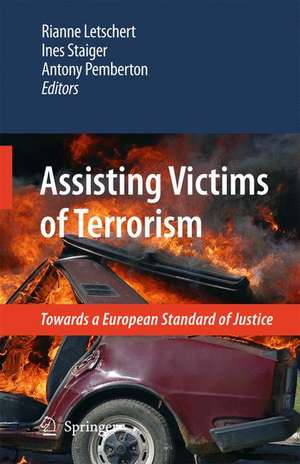Assisting Victims of Terrorism: Towards a European Standard of Justice
Editat de Rianne Letschert, Ines Staiger, Antony Pembertonen Limba Engleză Hardback – 21 dec 2009
| Toate formatele și edițiile | Preț | Express |
|---|---|---|
| Paperback (1) | 948.61 lei 6-8 săpt. | |
| SPRINGER NETHERLANDS – 2 noi 2014 | 948.61 lei 6-8 săpt. | |
| Hardback (1) | 954.62 lei 6-8 săpt. | |
| SPRINGER NETHERLANDS – 21 dec 2009 | 954.62 lei 6-8 săpt. |
Preț: 954.62 lei
Preț vechi: 1164.17 lei
-18% Nou
Puncte Express: 1432
Preț estimativ în valută:
182.66€ • 190.26$ • 152.28£
182.66€ • 190.26$ • 152.28£
Carte tipărită la comandă
Livrare economică 28 martie-11 aprilie
Preluare comenzi: 021 569.72.76
Specificații
ISBN-13: 9789048130245
ISBN-10: 9048130247
Pagini: 382
Ilustrații: XXXI, 348 p.
Dimensiuni: 155 x 235 x 37 mm
Greutate: 0.71 kg
Ediția:2010
Editura: SPRINGER NETHERLANDS
Colecția Springer
Locul publicării:Dordrecht, Netherlands
ISBN-10: 9048130247
Pagini: 382
Ilustrații: XXXI, 348 p.
Dimensiuni: 155 x 235 x 37 mm
Greutate: 0.71 kg
Ediția:2010
Editura: SPRINGER NETHERLANDS
Colecția Springer
Locul publicării:Dordrecht, Netherlands
Public țintă
ResearchCuprins
I. Introduction and Definitions.- 1. The Aim of the Study. 2. Methodology. 3. Contemporary Terrorism. 4. Defining Terrorism. 5. Defining Victims of Terrorism. 6. Defining Restorative Justice. 7. Concluding Observations. Bibliography.- II. International Initiatives and Activities focusing Specifically on Victims of Terrorism, including Exising International Instruments.- 1. Introduction into General Victims' Rights. 2. International Activities and Instruments. 3. Analysis of the Legal Status of EU Standards for Victims of Terrorism. 4. Justifying EU Involvement. 5. Concluding Observations. Appendix CoE Guidelines on the Protection of Victims of Terrorist Acts. Appendix UN Van Boven/ Bassiouni Principles. Bibliography.- III. Needs of Victims of Terrorism.- 1. Introduction: Consequences of Terrorist Victimisation and Needs of Victims of Terrorism. 2. The Needs of Victims. 3. The Differential Impact of Terrorism and related Needs. 4. Vicarious Victims and the Intergroup Context. Concluding Observations. Bibliography.- IV. Psyco-Social Assitance.- 1. Introduction. 2. A Stepped Care Approach to Mass Victimisation of Terrorism. 3. Community-based Interventions. 4. Information and Coomunication. 5. Concluding Observations. Bibliography.- V. Access to Justice and Administration of Justice.- 1. Introduction. 2. Access to Justice. 3. Administration of Justice. 4. Participation Rights for Victims of Terrorism. 5. Concluding Observations.- VI. Compensation.- 1. Introduction. 2. European Instruments relating to Compensation for Victims of Crime and Terrorism. 3. National State Compensation Funds for Victims of Crime in General. 4. Specific State Compensation Funds for Victims of Terrorism. 5. Ad Hoc Compensation Funds: The Victim Compensation Fund of 11 September 2001(VCF). 6. International Trust Funds. 7. Private Remedies. 8. Compensation through Criminal Proceedings. 9. Reparation for Victims of Terrorism. Concluding Observations. Bibliography. Appendix.- VII. Restorative Justice and Victims of Terrorism.- 1. Introduction. 2. Restorative Justice Principles and Values. 3. A Framework for Restorative Justice. 4. Restorative Justice Practices. 5. The Potential of Restorative Justice Practices for Victims of Terrorism. 6. Restorative Justice Responses to Terrorism. 7. Restorative Justice Practices in Context. 8. Towards a Conceptual Framework for Restorative Justice Processes for Victims of Terrorism at the Micro-, Meso- and Macro-level. 9. Towards a Global Restorative Justice Strategy in the Terrorism Context. 10. Concluding Observations. Bibliography.
Textul de pe ultima copertă
The large-scale terrorist attacks on 9/11 resulted in more attention being devoted to victims of terrorist acts. Discussions took place on how their needs could be best accommodated. The Madrid bombings in March 2004 gave further impetus to this process. This development is also part of a recent trend towards general victim of crime policies that branch out into specialized policies devised to meet the needs of particular groups of victims such as victims of trafficking, victims of sexual violence and abuse or victims of traffic accidents. However, although a movement of national and international solidarity relating to addressing the needs of victims of terrorism has developed, political consensus is still fragile.
This book provides a thorough analysis of the specific needs of victims of terrorism (using both legal and psycho-social studies), compared to victims of other forms of crime. The study combines different disciplines, enabling to combine the different perspectives leading to synergy in the analysis of the legal and psycho-social needs of victims of terrorism. Furthermore the appropriateness of restorative justice practices in the context of terrorism is included and provides challenging new insights.
This book provides a thorough analysis of the specific needs of victims of terrorism (using both legal and psycho-social studies), compared to victims of other forms of crime. The study combines different disciplines, enabling to combine the different perspectives leading to synergy in the analysis of the legal and psycho-social needs of victims of terrorism. Furthermore the appropriateness of restorative justice practices in the context of terrorism is included and provides challenging new insights.
Caracteristici
This is the first book dealing with specific assistance to victims of terrorism An interdisciplinary title where legal science and psychology Uniquely applies restorative justice theory to terrorism victims Includes supplementary material: sn.pub/extras









